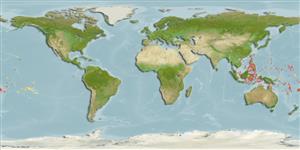>
Gobiiformes (Gobies) >
Gobiidae (Gobies) > Gobiinae
Etymology: Eviota: No etymology given, suggested by Christopher Scharpt: from Latin 'eu' for 'true' and 'iota' for anything very small, in combination 'truly very small' referring to it as being the smallest vertebrate at the time it has benn described by Jenkins (thus, making the suggestion by Scharpt plausible.; irrasa: From the Latin irrasa meaning unpolished or unshaved, in reference to the indiscrete nature of the pigmentation pattern of the head and trunk (Ref. 5289).
More on authors: Karnella & Lachner.
Environment: milieu / climate zone / depth range / distribution range
Sinh thái học
Biển gần đáy; Mức độ sâu 0 - 3 m (Ref. 58018). Tropical
Western Pacific: Cuyo Islands, Palawan, Philippines and the Southwest Islands of Palau.
Bộ gần gũi / Khối lượng (Trọng lượng) / Age
Maturity: Lm ? range ? - ? cm
Max length : 1.8 cm TL con đực/không giới tính; (Ref. 5289)
Short description
Khóa để định loại | Hình thái học | Sinh trắc học
Các tia vây lưng cứng (tổng cộng) : 7; Các vây lưng mềm (tổng cộng) : 9; Tia cứng vây hậu môn: 1; Tia mềm vây hậu môn: 8; Động vật có xương sống: 26. Characterized by the following: base of pectoral fin with two dark circular to oval spots, not sharply defined and often weakly connected, the upper spot somewhat larger than the lower; pectoral spots moderately pigmented, the intensity about equal to trunk bars; head (dorsally) and nape with dark, transverse, bars continuous over dorsal midline, and somewhat more heavily pigmented laterally; trunk with regular, dark, vertical bars, somewhat diffuse in outline, continuous over dorsal midline and usually not extending below midside anteriorly and much shorter posteriorly on peduncle; scale pockets dorsolaterally on trunk often weakly pigmented (Ref. 5289); characterized further by longitudinal scale series 24; ctenoid scales, absence on head, nape and base of pectoral fin; separated pelvic fins, only thin membrane joins bases; 8-11 branches on fourth pelvic ray; depth of body 4.1-4.7 in SL (Ref. 90102). Dorsal to anal fin-ray formula 9/8 (Ref. 116739).
Life cycle and mating behavior
Maturities | Sự tái sinh sản | Spawnings | Egg(s) | Fecundities | Ấu trùng
Karnella, S.J. and E.A. Lachner, 1981. Three new species of the Eviota epiphanes group having vertical trunk bars (Pisces: Gobiidae). Proc. Biol. Soc. Wash. 94(1):264-275. (Ref. 5289)
IUCN Red List Status (Ref. 130435)
Threat to humans
Harmless
Human uses
Các công cụ
Special reports
Download XML
Các nguồn internet
Estimates based on models
Preferred temperature (Ref.
123201): 25.1 - 29.3, mean 28.5 °C (based on 1584 cells).
Phylogenetic diversity index (Ref.
82804): PD
50 = 0.5000 [Uniqueness, from 0.5 = low to 2.0 = high].
Bayesian length-weight: a=0.00708 (0.00333 - 0.01504), b=3.09 (2.92 - 3.26), in cm total length, based on LWR estimates for this (Sub)family-body shape (Ref.
93245).
Mức dinh dưỡng (Ref.
69278): 3.0 ±0.3 se; based on size and trophs of closest relatives
Thích nghi nhanh (Ref.
120179): Chiêù cao, thời gian nhân đôi của chủng quần tối thiểu là dưới 15 tháng (Preliminary K or Fecundity.).
Fishing Vulnerability (Ref.
59153): Low vulnerability (10 of 100).
